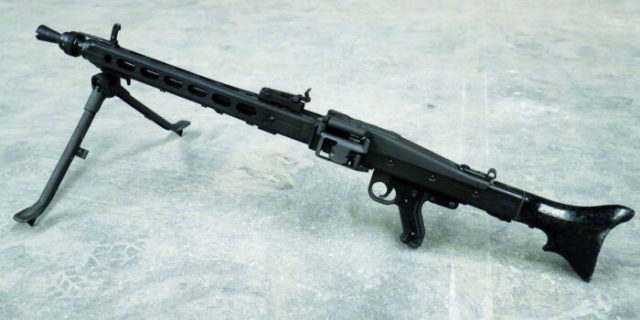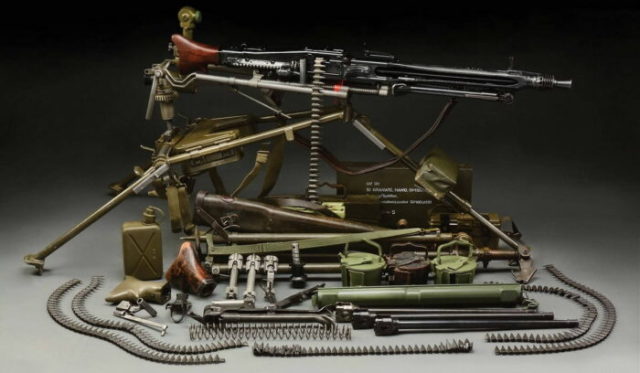According to the definition of one of the German publications, modern machine guns (Maschinengewehre, MG) are fully automatic support weapons with a high rate of fire and firepower. The supply of ammunition from him, as a rule, occurs with the help of a machine gun belt.
Automation works either using the energy of the shot (the principle of removal of powder gases), or using external, mainly electrical energy (external power supply). The main document for the classification and purchase of machine guns in the German Armed Forces are the final functional requirements (Abschließende funktionale Forderung, AF), approved on January 5, 2009. They divide modern machine guns into five product classes:
- light machine gun (caliber 5.56 mm x 45, MG4)
- medium machine guns (caliber 7.62 mm x 51, MG3 and MG5)
- medium-class machine gun with high rate of fire (caliber 7.62 mm x 51, MG6)
- heavy machine guns (caliber 12.7 mm x 99, M2, M3M)
- heavy machine gun for special purpose units (caliber 12.7 mm x 99)
This article is limited to those models of modern machine guns of the Bundeswehr that relate to hand-held small arms (firearms). 12.7 mm x 99 caliber machine guns mounted on the carriage (cal.50 BMG), the so-called heavy machine guns, the publication does not affect.
Modern machine guns – MG3 model
The MG3 machine gun dates back to the MG42 model, which was developed and produced during the Second World War. The MG42 differed from its predecessor MG34 mainly in two fundamental innovations:
- The production was carried out using sheet metal stamping technology instead of mechanical processing, which significantly increased production volumes and reduced the use of resources.;
- the hatch (roller) shutter replaced the previous shutter with a rotary face (head) and allowed a significant increase in the rate of fire from 900 to 1500 rpm. /min.

Modern machine guns of the Bundeswehr – MG3 model on a carriage
Initially, after the formation of the Bundeswehr in 1955, the MG42 was modified from the 8 mm x 57 IS caliber to the 7.62 mm x 51 NATO caliber. The machine gun also received an additional bolt lock, which – in combination with a new recoil spring – reduced the rate of fire to 1200 rounds/min. At the same time, it was possible to optimize barrel wear and ammunition consumption. This variant received the designations MG1 (new product) or MG2 (converted old products). Some adjustments followed, for example: the use of a new recoil amplifier and a change in the belt feed mechanism to ensure the use of a loose link tape.
The new design received approval on August 1, 1966, and was updated again on January 17, 1967. It became the basis of a modern machine gun under the designation MG3. Officially, the legitimization of the MG1, MG2 and MG3 models in the Bundeswehr took place on the basis of application permit No. 3315 of May 13, 1969.
The modern MG3 machine gun – as before MG1 – was produced by the Rheinmetall concern (Rheinmetall) in Dusseldorf until about 1977. Subsequently, production plants, especially metal stamping plants, were sold. In this connection, the main parts for the Bundeswehr machine guns of later orders in the period from 1987 to 1989 were manufactured under license, and the final assembly was carried out at Rheinmetall enterprises. In total, the Bundeswehr purchased more than 70 thousand modern MG3 machine guns in the form of new products.
Variants of the MG3 machine gun and features of their configuration
The German Armed Forces use the MG3 machine gun in two versions:
- used on foot or in a guided carriage, the so-called infantry machine guns received the designation MG3 (ohne Zusatz, Rus. – without supplement);
- used as a twin in armored vehicles or in a carriage with remote control, the so-called “blind” machine guns are designated as MG3A1.

MG3 machine gun on a bipod with a spare barrel and a "solid" (non-removable) tape
Both options are fundamentally interchangeable. The only difference is that the MG3A1 does not have an anti-aircraft sight, bipod, shoulder strap and shoulder rest (butt). It has a protective cap instead of a shoulder rest, a ball ring as a recoil booster and a second spare barrel. Among the modern machine guns currently in the military, the designations MG3 T ZUB or MG3A1 T ZUB are often found. This indicates that they are equipped with camouflage covers and accessories – technically, these weapons have not changed.
The kit of each MG3 model includes two, and the MG3A1 model has three barrels. Due to the high thermal load during rapid firing, the barrels are replaced after 150 shots using a valve to change the barrel to the right of the receiver.
Initially, the MG3 barrel bore had rifling and margins. At the intermediate stage, to guarantee the durability of at least 16 thousand shots, the barrels received solid conical chrome plating. Today, trunks are chrome-plated with a polygonal profile, the use of trunks with cut-field profiles is no longer allowed.

Firing from an MG3 mounted on a carriage
The entry into service of ammunition with a solid core to defeat protected targets has put the production of barrels in front of new challenges. Such ammunition is optimized for penetration into the target, but causes very strong erosion of the barrel. As a result, the process of chrome plating of the barrels of the MG3 machine gun of the latest production has undergone another optimization.
The modern MG3 machine gun has accessories for firing practical and blank ammunition. According to publications, for use in foreign missions of the Bundeswehr and during combat coordination before operations, there is an additional set of accessories that allows you to adapt optics and laser illumination modules to MG3. They allow – albeit very limited – to practice combat operations at night.
MG3 is intended only for conducting automatic (continuous) fire. The design of the weapon does not provide for the possibility of single firing. Ammunition is supplied using a “solid” or loose DM60 or M13 machine gun belt.

The output of "fired" links when using loose tape for ammunition
The high rate of fire of the weapon affects ammunition. Although the former MG42 was adapted to the NATO caliber of 7.62 mm, however, the cartridges used by the Bundeswehr partially differ from the NATO standard: the bottom of the cartridge cases is more durable than required to withstand the necessary pulling force of the cartridge from the tape.
Another feature of the modern MG3 machine gun is the sliding shutter used, with which the weapon can be put on the safety only when cocked. Moreover, this fuse differs from other fuses of small arms used in the Bundeswehr in both ergonomics and the applied safety concept. According to the concept, the protection of hand-held small arms should be guaranteed at all shutter positions.
Prospects for using the MG3 model
The MG3 machine gun was supposed to be gradually decommissioned and replaced with the MG5 by 2014 . But thanks to its high rate of fire, reliability and unlimited adaptability to the carriages, the MG3 still retains its permanent place in the troops. As an additional machine gun, the MG3 model remains in service with the Leopard 1 and Leopard 2 family of tanks, as well as the Marder BMP, since the spaces of the combat compartments of this armored vehicle do not allow mounting the MG5 without a comprehensive change in the attachment (carriage).
The age of the weapon, combined with intensive use, leaves a clear mark on the material. First of all, the MG3 receiver often shows load-related cracks that are not subject to further repair. Attempts to acquire replacement receiver boxes on the world market that meet the Bundeswehr quality standards ultimately failed.
According to a number of Western experts, it is likely that the knowledge of sheet metal stamping technology of this part has been lost in recent decades. Its updating, but only in the new specification is possible only for a large series of products. The latter would become economically justified with investments in the corresponding production facilities. However, due to the widespread availability of the successor model, the MG5 model, such a scenario is excluded.

MG3A0A1 machine gun on bipod
In order to maintain the operability of the existing arsenal of modern MG3 machine guns until the end of the period of use, it was necessary to resort to an unconventional approach. In particular, the Rheinmetall concern received an order for milled receiver boxes to cover the remaining needs. MG3 machine guns with such new receiver boxes received the designation MG3 A0A1 or MG3 A1A1.
According to experts, the irony is that the success of MG42 was due to the introduction of sheet metal stamping technology. Now it is possible to keep MG3 in operation only by abandoning this production technology.
Modern MG3 machine gun: tactical and technical characteristics

Modern MG3 machine gun
- principle of operation: recoil barrel with rigid roller locking, movable barrel
- Caliber: 7.62x51 mm NATO
- ammunition: machine gun belt
- length with/without butt: 1225mm/1075mm
- width: 130 mm
- height: 205 mm, 270 mm with overhead anti-aircraft sight
- barrel length: 565 mm
- bullet rotation: uniform right-hand rifling
- MG3 weight: 10.2 kg, 11.5 kg with bipod and portable belt
- MG3A1 weight: 10.0 kg, 10.2 kg with ball ring and protective cover
- Rate of fire: 1150+/- 150 shots per minute
- Muzzle velocity of the bullet: about 820 m/s
- trigger force: 60-80N
- firing range: up to 600 m on a bipod, up to 1200 m on a machine/carriage
According to the materials of the resource esut.de
Continuation: MG4 Machine Gun

